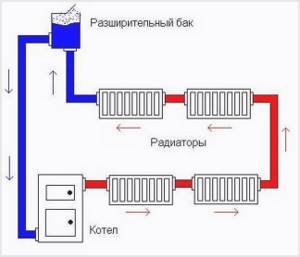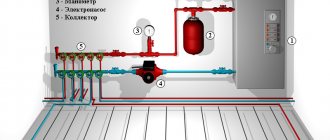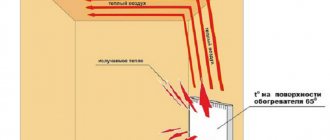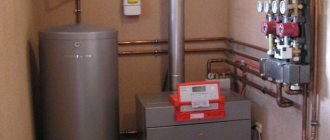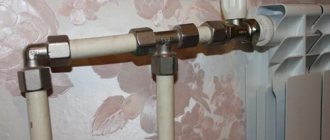Heating a house 100 m²
Really, honestly, really
| Heating a house 100 m² from | RUR 49,500 |
| Installation of heating boiler | 8,000 rub. |
| Installation of heating radiators (no more than 10 pieces)!!! The cost of installing a standard (mounted, not in-floor convector) heating radiator is 4,000 rubles | 25,000 rub. |
| Radiator pipe routing | 12,000 rub. |
| Pressure testing and filling with coolant | 4,500 rub. |
| TOTAL turnkey: | RUB 49,500 |
| Drilling holes, rigging, dismantling, paid extra | according to_estimate |
Heating a house 100 m² Attention. This cost is a preliminary estimate; these prices should only be used as approximate prices. The exact cost of the work is calculated after an engineer visits the work site, its complexity, and quantity.
Cost of materials from 120,000 rubles
Included by type of work
| Boiler installation | Installing an electric boiler on a wall or floor |
| Installation of pipes without “grooving” | Open pipeline installation with wall or floor mounting |
| heating radiators | Mounting the heating device on the wall, installing fasteners |
| System pressure testing | Pressure testing of the assembled system with an air compressor to identify possible leaks |
| Commissioning works | Filling with coolant (antifreeze or water), removing air from the heating system during work |
| !!! No heated floors | It is calculated additionally, it requires coordination of the type of substrate for the pipes, the type of use of the pipe, the possibility of control and automatic control, and of course the footage |
| !!! Without external chimney | To calculate the cost, an engineer’s visit is required, an inspection of the roof structure, window location and much more. |
House heating
Design features
For a gravity system to work effectively, the following requirements must be met:
- the heat source is any non-volatile heat generator with outlet pipes with a diameter of 40-50 mm;
- at the outlet of a boiler or stove with a water circuit, an accelerating riser is immediately installed - a vertical pipe through which the heated coolant rises;
- the riser ends with an open-type expansion tank installed in the attic or under the ceiling of the upper floor (depending on the type of wiring and the design of the private house);
- tank capacity – 10% of the coolant volume;
- by gravity, it is advisable to choose heating devices with large internal channels - cast iron, aluminum, bimetallic;
- for better heat transfer, heating radiators are connected according to a versatile pattern - bottom or diagonal;
- special full-bore valves with thermal heads (supply) and balancing valves (return) are installed on the radiator connections;
- It is better to equip batteries with manual air vents - Mayevsky taps;
- replenishment of the heating network is organized at the lowest point - near the boiler;
- all horizontal sections of pipes are laid with slopes, the minimum is 2 mm per linear meter, the average is 5 mm/1 m.
On the left in the photo is the coolant supply riser from a floor-standing boiler with a pump on the bypass, on the right is the return line connection
Note. Slopes perform 2 functions - they help the coolant flow in the desired direction, and the air rises through the pipelines and leaves through the open expansion tank. A caveat regarding the radiators used: if the system is built correctly, steel panels also heat well.
Gravity heating systems are made open and operated at atmospheric pressure. But will gravity flow work in a closed circuit with a membrane tank? We answer: yes, natural circulation will continue, but the speed of the coolant will decrease and efficiency will drop.
It is not difficult to substantiate the answer; it is enough to mention the change in the physical properties of liquids under excess pressure. With a pressure in the system of 1.5 Bar, the boiling point of water will shift to 110 °C, and its density will also increase. The circulation will slow down due to the small difference in the masses of the hot and cooled flow.
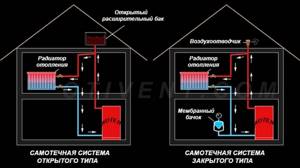
Simplified gravity flow diagrams with an open and membrane expansion tank
Installation of water supply heating systems Klin, Klinsky district
Heating cost calculation
The cost of repairing heating systems
Cost of installation of water supply
Similar services:
Heating a house without a pump Having decided to build a private house, every owner must carefully consider heating, since you will not be able to live through the winter without it. In cities everything is much simpler. The heating system was originally designed and cannot be changed. In a country house, all design issues...
Heating Moscow Our organization has been designing, completing, repairing and installing autonomous heating systems in Moscow and the Moscow region for a long time. We are proud of the excellent reputation that has developed among the population of this area thanks to our professionalism, responsibility and unlimited loyalty to customers. Organization of autonomous heating of a private house in…
Heating a private country house Modern individual heating systems Currently, several heating systems are used: stove, gas, electric, steam. Steam is used mainly as central heating for apartment buildings. To implement this type of heating, it is necessary to create communications isolated from the surrounding conditions, build a workshop or...
Heating and boiler room Heating of the house must be thought through before the construction of the house itself begins. Especially if this house is not just a light home for a summer resident, which he uses only in the warm season, but a full-fledged residential building, where people should live comfortably in the most…
Heating without electricity Many summer residents and owners of country real estate are interested in the possibility of organizing heating for their homes without electricity. Their concern is understandable; it is caused by disruptions in the supply of electricity in areas remote from the metropolis. When choosing a method of heating a home, they firstly do not want to depend on...
Installation of heating pipes In order to decide on the materials from which the heating pipes will be installed, you need to consider their strengths and weaknesses. You will learn about this by reading the article. You can also find a working life hack on how to assemble a polypropylene circuit without having either scissors or a soldering iron. Kinds…
Laying out heating pipes in a house Laying out heating pipes in a house is of great importance, since the efficiency of the system directly depends on it. It is necessary to draw up a detailed plan with thermal calculations in order to choose the optimal route for laying heating pipes. If you don't have the experience or time for this, order...
We do heating wiring of any configuration. You need heating wiring in a private house - the scheme is selected based on the characteristics of the home, the number of radiators and the available budget. Our plumbers will install the following types of heating wiring in a private home: Single-pipe. The radiators are connected in series using one circuit through which the coolant circulates....
Installation of in-floor convectors Connecting in-floor convectors from DESIGN PRESTIGE LLC Very often when planning the modern design of your own home, the installation of conventional radiators spoils the entire interior. The most optimal solution in such situations would be to install in-floor convectors, which are harmoniously integrated into the floor and can quickly...
Combined heating of a dacha Combined heating of a dacha Heating a dacha with a boiler alone with autonomous heating does not always bring the desired result. There are several reasons for this: incorrect choice of unit based on its power; increasing living space through extensions, which does not allow the boiler to cover the heating needs of the house. For this…
Heating a wooden country house It is important to consider heating a wooden country house as a system for creating comfortable living conditions, even if it is a country house. You can get a competent diagram only by making calculations. Factors such as the type of radiators, the thickness of the walls and their insulation, the average calculated...
Autonomous heating of a cottage: advantages Autonomous heating of a cottage Any owner of a private country home often faces the question of heating. To accomplish this task, it is necessary to decide on a source that will help fill the house with heat. There is, today......
Heating the cottage...
Heating a private dacha Organizing high-quality heating for a private dacha is the key to comfortable living in it for many years. The specificity of a country house is that it......
Replacing home heating It is no secret that in cold weather the issue of maintaining a comfortable temperature regime in the house is very relevant. Alas, not always...
Steam and wood heating Nowadays, there are two types of heating systems: steam heating and wood heating. These types of heating systems are most common both in private country houses and in apartments in all cities of the country. Consumers are particularly satisfied with this type of heating, because with their…
Heating a wooden house Thanks to the availability of materials, wooden houses have always been one of the most popular in Russia. Today, with the development of modern technologies, quite a lot of competing materials have appeared, but wood is still in demand. Each material has different thermal conductivity characteristics and requires individual calculation of the heating system. Let's consider...
Heating installation Incorrectly set levels of coolant movement during natural convection, illiterate piping, will negate all preliminary costs. As a recommendation, this work should be performed by specialists. Heating installation is not just about laying pipes; it requires competent heat and power calculations, which can only be done…
Warm floors from a boiler room Country houses and cottages are often impossible to connect to a central water supply, much less heating. Therefore, heating and hot water supply must be organized independently. We are talking about autonomous heating and water supply. Autonomous boiler room In order to ensure comfortable living in a private house…
Which scheme is better, forced or natural?
A natural system is better if you need to organize heating for a small one-story private house. In this case, there is no point in spending money on pumping equipment when the natural coolant current will be sufficient to heat the entire building.
Forced circulation circuits are best used in large one-story or multi-story buildings. Thanks to the rapid movement of the coolant in the network, buildings of significant size will be heated well and evenly. Natural circulation circuits will not cope with this task.
Requirements for arrangement and operation
When installing heat supply to a home, it is important to take into account a number of features of an open heating system:
- To ensure normal circulation, the boiler is installed at the lowest point in the line, and the expansion tank at the highest point.
- The optimal place to place the expansion tank is the attic. During the cold season, the container and supply riser within the unheated attic must be insulated.
- The laying of the main line is carried out with a minimum number of turns, connecting and fitting parts.
- In a gravity heating system, water circulates slowly (0.1-0.3 m/s), so heating should occur gradually. Do not allow it to boil - this accelerates the wear of radiators and pipes.
- If the heating system is not used in winter, the liquid must be drained - this measure will keep the pipes, radiators and boiler intact.
- The coolant level in the expansion tank must be monitored and periodically replenished. Otherwise, air pockets will appear in the line, reducing the efficiency of the radiators.
- Water is the optimal coolant. Antifreeze is toxic and is not recommended for use in systems that have free contact with the atmosphere. Its use is advisable if it is not possible to drain the coolant during an unheated period.
Particular attention is paid to calculating the cross-section and slope of the pipeline. Design standards are regulated by SNiP number 2.04.01-85.
In circuits with gravitational movement of the coolant, the cross-sectional size of the pipe is larger than in pumping circuits, but the total length of the pipeline is almost two times less. The slope of the horizontal sections of the system, equal to 2 - 3 mm per linear meter, is suitable only when installing heat supply with natural movement of the coolant.

Failure to comply with the slope when installing systems with natural movement of coolant leads to airing of the pipes and insufficient heating of radiators distant from the boiler. As a result, thermal efficiency decreases
Boiler design without electricity
The gas boiler, independent of electricity, has:
- 2 gas burners – pilot and main;
- Combustion chamber - in such devices it is open for better traction;
- Automation;
- Boiler safety system - temperature sensor, backdraft valve (it is needed to regulate the operation of the chimney);
- Heat exchanger.
The system of a non-volatile gas boiler must have an open expansion tank, since when the coolant heats up, the liquid expands. And this is what promotes coolant circulation. But during expansion, excess is formed, which enters this tank.
Ignition in such gas boilers occurs using a piezoelectric element, which operates when a button is pressed. With its help, the pilot burner is ignited, and from it the main gas burner is ignited, thanks to which the heat exchanger is heated and the desired temperature of the liquid is maintained.
After some time, the gas does not flow and the burner goes out, after the heat exchanger has cooled down the process repeats.
How does a heating system without a pump work - options and device options
To make it possible to live in a built house outside the city regardless of the time of year, it needs high-quality heating. Among the wide variety of devices for heating a room, it is sometimes difficult to decide what exactly is needed in different life situations. One of the simplified options that can be equipped on your own is a heating system without a pump, in other words, with a real type of coolant circulation. In fact, we will talk about this type of heat supply further in the material.
